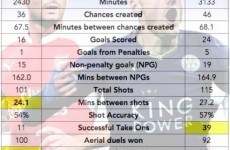- 0
In the run-up to the next crucial meeting on Thursday of Portsmouth’s creditors at Fratton Park, Guy Thomas, Head of Insolvency at SA Law LLP , who has blogged extensively on Pompey’s woes, takes a look at the key players in the insolvency of Portsmouth City Football Club in its transition from Premiership club to administration and future CVA / liquidation.
.
.
.
By Guy Thomas
15 June 2010
Pompey went into administration on 26 February 2010 when Andrew Andronikou and two other partners from a specialist insolvency firm, UHY Hacker Young, were appointed. Portsmouth, reported at the time as having debts of about £60m, became the first Premier League club to enter administration. Unsecured claims have since exceeded the £100m mark. Sportingintelligence was the first media outlet to reveal details of the extended debts, back on 21 April.
Since the administrators’ appointment, the club has been the subject of a lot of interest and that will continue with Thursday’s meeting of the creditors, called to consider the current administrators’ proposals for the company to enter a Company Voluntary Arrangement (CVA).
The original CVA proposal from UHY Hacker Young put forward a dividend of £20p in the £, rising to £25p in the £ if the club is promoted. This has recently been challenged by a rival insolvency firm, Griffins. Griffins’ counter proposal put forward (on behalf of some unsecured creditors) three suggested modifications to the CVA with proposed increases in the dividend to creditors (if their modifications were accepted) ranging from 65p in the £ all the way up to 99p. Amongst the inevitable comment and posturing (by both sides) that has followed, it is easy to forget that amid the noisy competing interests connected to Pompey’s troubles, there are some sincerely held concerns on all sides. The main protagonists are as follows:
.
1. Her Majesty’s Customs & Revenue (HMRC)
HMRC has increased its claim against the club since the beginning of the administration. Along with its claims concerning tax due for “image rights” the total claim from HMRC now stands at c.£35m. The administrator, Andrew Andronikou, has already indicated that he might challenge part of that claim so, by implication, he may seek to challenge its potential role in the vote on Thursday.
In any proposed CVA there is always a key issue for concerned creditors: who might be keen to force an investigation/prosecution of any alleged misdemeanors of the former regime, that their efforts could hamper the re-emergence of any “new” club out of the CVA?
This pressure to investigate the old regime has been best expressed by HMRC and it is clear that it was mainly HMRC’s intervention prior to / at the last meeting that lead to the current CVA-sale of the business to by route of “new” club and liquidation of “old” club, that is currently proposed by the administrators.
Unusually for HMRC, it got involved early in Pompey’s administration, initially filing a challenge to the validity of the current administrators appointment (then backing away from that challenge at the second hearing).
HMRC gave early signals of a desire for the kind of thorough investigation of former directors and connected parties that liquidation is best suited for. A liquidator has extensive powers of investigation /prosecution that are less readily available in other forms of insolvency such as a CVA or administration.
It’s is very rare for a business involved in such a process to return much of a dividend for creditors except where a large recovery has come from a claim against old directors or parties connected to the club.
During the course of Pompey’s insolvency, HMRC has also initiated a thorough review of how clubs reward players for their “image rights” (in ways that are “tax lite”). This has yet to work itself through but given the desire of HMRC to be seen to be collecting as much as possible then it will likely be dramatic when it does emerge.
More recently, HMRC has filed a petition against The Premier League over the “football creditors rule” whereby football creditors get a better return from a club’s insolvency then ordinary creditors (like themselves). This rule is particularly galling to HMRC as it gave up a similar “special” status when the administration regime changed in 2003. Its challenge will take some time to come to court and won’t directly influence the Portsmouth insolvency until either the parties negotiate a settlement or a court makes a ruling. Any substantial hearing on this claim is probably many months away.
.
2. The (other) creditors
These are many and diverse; they range from those keen to avoid the cost and delay of an investigation into what went wrong, to those that are closely linked to the old Portsmouth regime and want a new club to successfully emerge quickly and others that are keen to maximize their dividend and are possibly indifferent to the club’s future football success.
Many are unconnected to the old regime and feel hard done by for their prior loyalty, whilst others were inextricably linked with the business and fear the stress and cost of future investigations into their dealings with the club.
Only one of these creditors (Mr Balram Chainrai) placed the Club into administration and appointed the current administrators but all of them have a right to be involved in deciding its future.
I suspect many creditors just want the best deal possible without destroying the chances of the future club.
The pressure to increase the dividend (without destroying the new club’s prospects) has been best expressed by the Griffins proposal. Despite the war of words between UHY Hacker Young and Griffins that followed proposed modifications to the original CVA proposal, Griffins are acting for creditors that appear to understand that the future level of dividend is linked to the financial success of the “new” club. Unlike the current administrators they appear to believe that there is more “margin” within the current business plan for them to directly benefit from.
An increased dividend for creditors (above the current 20/24p in the £) that doesn’t look likely to “break” the new club will be seen as a good result for them out of the imminent meeting.
.
3. The fans
Sadly under the current system, unless they are also creditors or members of the media they will have no direct say in the outcome of the meeting. Their voice will be heard however depending on how well they receive the “new” club and whether they support it with ticket sales and merchandising. Without their enthusiasm, loyalty and of course money the new club and the CVA depending upon it will fail.
.
4. The football leagues
Where did it all go so wrong? Not long ago the Premier League was lauded as exemplary in the modern game, the financial model against which other leagues internationally were measured. Now it faces potential challenge from government over governance, from international organisations (such as Uefa) over financial management, and most recently (along with the Football League), a challenge from HMRC over the “football creditors rule” and the tax treatment by clubs of “image rights”. Pompey’s saga has played a role in tarnishing the Premier League’s previously excellent reputation and the Football League will not wish to repeat their experience.
Although both leagues (the Premier League & Football League) were listed as creditors in the Report to Creditors from April 2010, neither are listed as unsecured creditors in the CVA proposal.
It would appear to be in the interest of both the Premier League and the Football League to help close the book on Pompey, assist with any parachute payments to the club, agree the transfer of the “football share” to the “new” club and hope to deal with the other challenges in their own time without the current pressure caused by Pompey’s semi-permanent presence on the front page of the sports media. It will probably also help that a new season in the Championship will lessen the media’s interest in Pompey going forward. Neither league will play a direct role in Thursday’s meeting but they will be sure to be keeping a close eye on proceedings.
Unless the Football League approves the exit from Administration by way of CVA (which it has indicated is the preferred route) then the club faces a further deduction of points (in the Championship).
.
5. The “buyer”
Whoever buys the club will obviously want their money’s worth. They will also quite properly, want it to be as viable a commercial proposition as possible. The value of the business in inextricably linked to how much money it has after “paying out” to the CVA creditors. Put another way, the level of dividend decided by the creditors directly affects the “price” the buyer will be prepared to pay for the business after any CVA is approved. Too much of a dividend will indirectly drive down the value of the “new” club, potentially making it less attractive to new buyers and investors. If the field of buyers is reduced to one (say, Mr. Chainrai), then this in turn must affect the final negotiations.
.
6. The current administrators
The three partners of UHY Hacker Young will have one overwhelming objective; and it’s not just to avoid messing up the most high-profile appointment their firm has taken to date.
It is the desire to restructure the existing “old” club and sell its football assets to a “new” football club that will be capable of producing dividends over nearly five years and not “fall over” under its obligations whilst the CVA still lasts.
Appointed by one of the companies of Mr. Chainrai, backed by the additional funding of Mr. Chainrai’s companies, and likely to sell the “new” club to a company controlled by Mr. Chainrai, they were always going to have to deal with queries over their independence and how they act upon their duty (as administrators) to work in the interests of all creditors.
The proposal put forward by the current administrators is their attempt to achieve that “balance”.
.
Whatever the outcome, pushed and pulled by the forces set out above, the final result from the meeting may not reflect a fair balance between those interests but if handled properly the meeting should afford a good opportunity of all concerned to influence and shape the outcome and ultimately for most creditors to decide upon the outcome. And if it doesn’t? Well there’s always an application to the court. But that’s for another blog.
At the meeting on Thursday, the creditors will
- approve the current administrators proposal OR
- modify it to their preferred ends (i.e. seek to increase the dividend) OR
- reject it outright
If the chairman of the meeting (likely to be Mr Andronikou) chooses to, or if the meeting votes for it, the chairman can also adjourn the meeting to another date, to be held within 14 days unless extended by the court, in order for the creditors to consider a proposed modification to the proposal.
This still has some way to go.
.
More stories mentioning Portsmouth
Find out what the world’s top sportsmen REALLY earn, at our database, and in our Global Sports Salaries report










